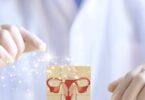Being a woman in her mid to end 30s looking at glossy magazines it’s easy to get frustrated. There is a seemingly endless list of celebrities who became mothers in their mid to late 40s or even in the beginning of their 50s. The latest example is supermodel Naomi Campbell . Yet no matter how many celebrities show off their baby bumps or newborns, a basic biological truth is still that fertility declines with increasing age.
Age-related fertility decline
Over the past four decades, due to cultural and social changes, women in the developed world have significantly delayed childbirth. This trend is even more pronounced when you look at patients who attend infertility clinics. It is well-known that live birth rates in women older than 35 are significantly lower than in those younger, both naturally and with assisted reproduction.
Healthy pregnancy requires interaction of many different factors ranging from neuroendocrine to uterine, as well as good oocyte quality. Given that after oocyte donation, aging women can enjoy consistent live-birth rates as well, most experts believe that oocyte quality is the major contributing factor responsible for age-related fertility loss.
How are older oocytes different?
Oocytes are in a woman’s body from the time she has been born and they age with her. Science has found that aging oocytes show a number of changes impairing their quality. There are several types of changes to their chromosomes and they have reduced capacity to repair DNA damage. In addition to that they have a significantly lower energy content. While it is likely that all of these factors contribute concomitantly to fertility decline, it is especially the lower energy content that has raised scientific interest, as it presents as an interesting target for novel therapeutic strategies.
Energy makes the world go round
Ask any primary school kid and they know about Einstein. One of his primary achievements was without a doubt that he was able to explain that in the end all that really matters is energy in its various forms. And that’s also true for our body – even down to its smallest entities, the cells. In almost every cell of our body there are specific cellular organelles dedicated to the generation of energy. They are called mitochondria and they are often referred to as the cellular power plants.
Mitochondria are in fact truly intriguing cellular organelles for many reasons. They are passed down from mother to daughter and even contain their very own DNA (mtDNA). They’re able to transform the nutrients we take up with our food into the universal energy currency of our body which is called adenosine triphosphate or ATP for short. Not surprisingly, oocytes are among the cells that have one of the highest number of mitochondria. The processes of oocyte maturation and the first stages of embryonic development require huge amounts of energy after all.
Mitochondria, energy and oocyte quality
Cellular energy content is closely associated not only to the number of mitochondria, but also to their function. Abnormalities in quantity, quality, and function of mitochondria are all closely related to poor fertility and disorders, such as decreased ovarian reserve (DOR), premature ovarian aging (POA), and ovarian aging. Mitochondria have begun to become a therapeutic target for infertility caused by factors such as poor oocyte quality, oocyte aging, and maternal mitochondrial genetic diseases.
Mitochondrial replacement therapy (MRT) – promising, but no standard procedure
A rather invasive and still not widely used therapeutic option is mitochondrial replacement therapy (MRT). With it, doctors use heterologous (from donors) or autologous (from own tissue) mitochondria to rebuild the healthy state of oocyte. It works either by increasing the amount of mitochondria (e.g., partial ooplasm transfer, autologous mitochondrial transfer), or by replacing abnormal maternal mitochondria (e.g., pronuclei transfer, spindle transfer, polar body transfer).
Autologous mitochondria transfer of mitochondria extracted from healthy tissue and supplied to damaged tissue has first been used to treat cardiac-compromised newborns. By many IVF experts it is considered the most promising therapeutic technology as of today. This is mainly due to the fact that no donor is needed. However, its clinical efficacy is still controversial and it will very likely require many more years of intense research before it will become a standard procedure.
Simple and safe natural treatment: Orthomolecular therapy
The good news is that there is a simple and safe natural treatment method to improve mitochondrial activity in mature but healthy women. It is non-invasive, inexpensive and ideal for mature women aiming to improve mitochondrial function in a natural way. It is called orthomolecular therapy. Orthomolecular therapy is a form of alternative medicine that aims to maintain health through targeted nutritional supplementation. From a mitochondrial perspective, a key player is the micronutrient coenzyme Q10 (CoQ10).
Mitochondrial nutrient coenzyme Q10
Coenzyme Q10 acts in the inner mitochondrial membrane and is essential for mitochondrial energy synthesis. While children and young adults produce coenzyme Q10 (CoQ10) endogenously in sufficient quantities, tissue concentration declines with age and expression of enzymes involved in CoQ10 synthesis is reduced in immature oocytes of older women.
Supplementing coenzyme Q10 has been shown to effectively support fertility treatment in mature patients, improving oocyte quality significantly.
Coenzyme Q10 supplementation improves oocyte quality
A Canadian team of scientists lead by Yaakov Bentov were among the first to demonstrate that supplementation of coenzyme Q10, by supporting energy generation, can improve genetic health of oocytes, increase number of top quality embryos, and raise clinical pregnancy rate.
Today, other studies suggest that it may also support functioning of cumulus cells (a group of closely associated cells that surround the oocyte and participate in the processes of oocyte maturation and fertilization), reduce detrimental oxidative stress and prevent cell death in postovulatory aged oocytes. Furthermore, Sirtuin 4 (SIRT4), which was first found to be up-regulated in postovulatory aged oocytes, decreased following CoQ10 treatment. Sirtuin 4 is a mitochondrial protein which in humans is encoded by the SIRT4 gene. It belongs to the sirtuin groups of proteins which are known to mediate changes in the metabolic status of cells and regulate diseases of ageing, including neurodegeneration, diabetes, cardiovascular diseases and cancer.
How to use it
If you, too, want to try this natural treatment option, simply choose fertility vitamins with coenzyme Q10 and take them once daily with your breakfast. Studies suggest that you experience benefits after a 3 months regimen.
References
Ben-Meir A, Kim K, McQuaid R, Esfandiari N, Bentov Y, Casper RF, Jurisicova A. Co-Enzyme Q10 Supplementation Rescues Cumulus Cells Dysfunction in a Maternal Aging Model. Antioxidants (Basel). 2019 Mar 8;8(3):58. doi: 10.3390/antiox8030058. PMID: 30857157; PMCID: PMC6466589.
Ben-Meir A, Burstein E, Borrego-Alvarez A, Chong J, Wong E, Yavorska T, Naranian T, Chi M, Wang Y, Bentov Y, Alexis J, Meriano J, Sung HK, Gasser DL, Moley KH, Hekimi S, Casper RF, Jurisicova A. Coenzyme Q10 restores oocyte mitochondrial function and fertility during reproductive aging. Aging Cell. 2015 Oct;14(5):887-95. doi: 10.1111/acel.12368. Epub 2015 Jun 26. PMID: 26111777; PMCID: PMC4568976.
Bentov Y, Hannam T, Jurisicova A, Esfandiari N, Casper RF. Coenzyme Q10 Supplementation and Oocyte Aneuploidy in Women Undergoing IVF-ICSI Treatment. Clin Med Insights Reprod Health. 2014 Jun 8;8:31-6. doi: 10.4137/CMRH.S14681. PMID: 24987272; PMCID: PMC4071761.
Bentov Y, Casper RF. The aging oocyte–can mitochondrial function be improved? Fertil Steril. 2013 Jan;99(1):18-22. doi: 10.1016/j.fertnstert.2012.11.031. PMID: 23273985.
Jiang Z, Shen H. Mitochondria: emerging therapeutic strategies for oocyte rescue. Reprod Sci. 2021 Mar 12. doi: 10.1007/s43032-021-00523-4. Epub ahead of print. PMID: 33712995.
Xing X, Zhang J, Zhang J, Wang Y, Wang J, Kang J, Quan F, Su J, Zhang Y. Coenzyme Q10 supplement rescues postovulatory oocyte aging by regulating SIRT4 expression. Curr Mol Pharmacol. 2021 Apr 19. doi: 10.2174/1874467214666210420112819. Epub ahead of print. PMID: 33881976.







